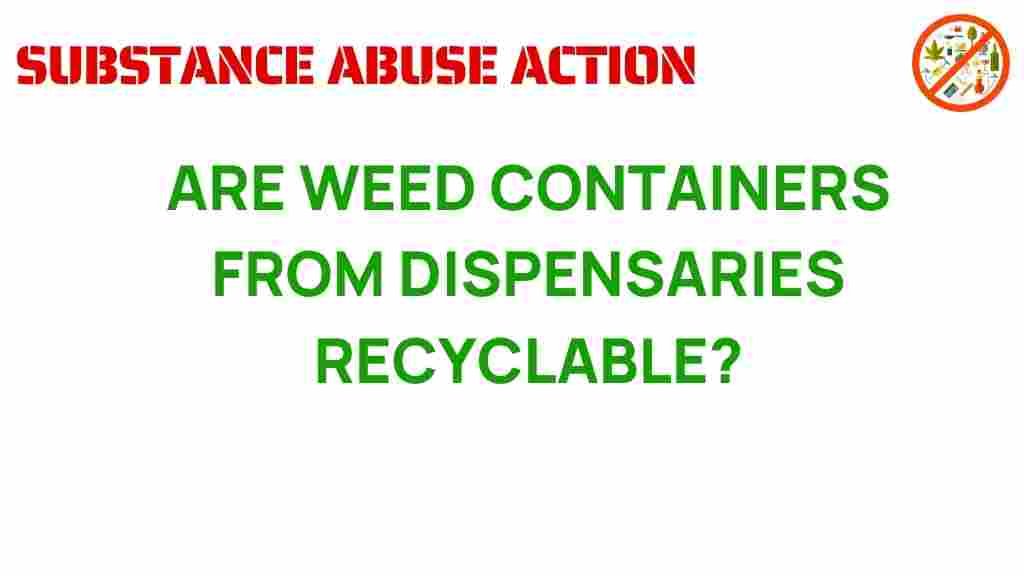Are Dispensary Weed Containers Really Recyclable?
The cannabis industry has seen explosive growth over the past few years, and with it, the demand for eco-friendly practices has surged. As consumers become more conscious of their environmental impact, the question arises: are dispensary weed containers really recyclable? This article explores the sustainability of cannabis packaging and the role of dispensaries in reducing plastic waste.
The Importance of Recycling in the Cannabis Industry
With the rise in cannabis consumption, especially in legalized states, the environmental impact of cannabis packaging has come under scrutiny. Many dispensaries use plastic containers for their products, leading to concerns about plastic waste and sustainability. Understanding the importance of recycling can help consumers make informed choices.
- Plastic Waste: The cannabis industry contributes significantly to plastic waste, with many dispensary weed containers made from materials that are not easily recyclable.
- Environmental Impact: Improper disposal of these containers can lead to pollution and harm wildlife.
- Consumer Awareness: Educating consumers about the recyclability of weed containers can encourage more sustainable practices.
Types of Dispensary Weed Containers
Before diving into the recyclability of these containers, it’s essential to understand the various types of packaging used in dispensaries:
1. Plastic Containers
Most dispensaries use plastic containers for their weed products. These containers are lightweight and help maintain the freshness of cannabis. However, they are often made from materials like PET or PVC, which can be problematic when it comes to recycling.
2. Glass Containers
Glass is a more sustainable option compared to plastic. It is recyclable and does not leach harmful chemicals, making it a preferred choice for many eco-conscious consumers.
3. Paper and Cardboard Packaging
Some dispensaries opt for paper or cardboard packaging. These materials are generally more recyclable and biodegradable, contributing to a lower environmental impact.
Understanding the Recycling Process for Weed Containers
To determine if dispensary weed containers are truly recyclable, it’s crucial to understand the recycling process:
Step 1: Identify the Material
Check the bottom of the weed container for the recycling symbol and the number within it. This symbol indicates the type of plastic used, which determines its recyclability.
Step 2: Clean the Containers
For most recyclables, it’s important to clean the containers before placing them in the recycling bin. Residual cannabis oils can contaminate the recycling stream.
Step 3: Check Local Recycling Guidelines
Recycling rules vary by location. It’s essential to check your local recycling program to see if they accept the type of weed container you have.
Step 4: Dispose of Properly
Once you’ve confirmed that the container is recyclable, dispose of it in the appropriate recycling bin. If it’s not recyclable, consider reusing it or finding a specialized recycling program.
Troubleshooting Common Recycling Issues
Even with the best intentions, consumers can encounter challenges when recycling weed containers. Here are some common issues and solutions:
1. Contamination
Problem: Containers that are not cleaned properly can contaminate the recycling stream.
Solution: Always rinse out containers before recycling. This simple step can help ensure that materials are properly processed.
2. Confusion Over Materials
Problem: Many consumers are unsure about the recyclability of different types of plastics.
Solution: Familiarize yourself with the different recycling symbols and what they mean. For instance, #1 (PET) and #2 (HDPE) are widely accepted, while others may not be.
3. Lack of Local Facilities
Problem: Some areas do not have facilities that accept certain types of weed containers.
Solution: Research local recycling programs or consider returning containers to retailers that offer take-back programs.
Dispensaries and Sustainability: What They Can Do
Dispensaries play a significant role in the sustainability of the cannabis industry. Here are ways they can contribute:
- Use Eco-Friendly Packaging: Opting for biodegradable or compostable materials can significantly reduce plastic waste.
- Implement Take-Back Programs: Encouraging customers to return used containers can promote recycling and reduce litter.
- Educate Consumers: Dispensaries should provide information on the recyclability of their products and promote sustainable practices.
Consumer Awareness and the Future of Cannabis Packaging
As consumers become more aware of their environmental impact, they are demanding more sustainable options in cannabis packaging. The following trends are shaping the future:
- Increased Demand for Recyclable and Biodegradable Packaging: Consumers are willing to pay more for products that are packaged sustainably.
- Innovation in Materials: Companies are exploring new materials that are both effective for packaging and environmentally friendly.
- Transparency in Sourcing: Brands are being encouraged to disclose information about their packaging materials and recycling options.
Conclusion: Making Informed Choices
In conclusion, the recyclability of dispensary weed containers is an important consideration for environmentally conscious consumers. While some containers are recyclable, others may contribute to plastic waste if not disposed of properly. It’s vital for consumers to be informed about the materials used in cannabis packaging and to engage with dispensaries that prioritize sustainability.
Ultimately, consumer awareness and demand for eco-friendly practices will drive the cannabis industry towards more sustainable solutions. By choosing products with recyclable or biodegradable packaging, you can help reduce the environmental impact of cannabis consumption. For more information on sustainable practices in the cannabis industry, visit Green Matters.
Let’s work together to ensure that the cannabis industry evolves in a way that respects our planet, promotes sustainability, and minimizes plastic waste.
This article is in the category Health and created by SubstanceAbuseAction Team
